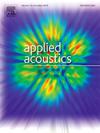Assessing human responses to construction noise using EEG and EDA signal features with Consideration of individual sensitivity
IF 3.4
2区 物理与天体物理
Q1 ACOUSTICS
引用次数: 0
Abstract
Construction noise significantly affects the mental and physical well-being of both workers and urban residents. Recent studies on noise stress monitoring have explored physiological sensing-based techniques for efficient noise management, primarily focusing on human responses to sound pressure levels. However, these studies often overlook variations in individual responses and personal traits, such as noise sensitivity. This study examines the effectiveness of combining electrodermal activity (EDA) and electroencephalography (EEG) signal features with individual noise sensitivity to assess individually varying stress responses to construction noise. Data were collected from 20 participants exposed to 40, 60, and 80 dBA noise levels, recorded at an actual construction site. Additionally, participants’ noise sensitivity as a personal trait and subjective annoyance as a stress response to noise were evaluated. The findings indicate that EDA and EEG signals provide more accurate and nuanced assessments of individual stress responses than traditional noise evaluations based solely on sound pressure levels. Integrating individual sensitivity traits with physiological data enhanced the accuracy and personalization of stress assessments, highlighting the importance of considering individual differences in noise management strategies. These insights underscore the need to advance noise regulations beyond sound pressure thresholds, advocating for human-centered approaches that incorporate physiological monitoring.
考虑个体敏感性,利用脑电图和EDA信号特征评估人类对建筑噪声的反应
建筑噪声对工人和城市居民的身心健康都有显著影响。最近对噪声应力监测的研究已经探索了基于生理传感的有效噪声管理技术,主要关注人类对声压级的反应。然而,这些研究往往忽略了个体反应和个人特征的变化,比如噪音敏感性。本研究探讨了将皮肤电活动(EDA)和脑电图(EEG)信号特征与个体噪声敏感性相结合,以评估个体对建筑噪声的不同应激反应的有效性。数据来自20名参与者,他们暴露在实际建筑工地记录的40、60和80 dBA的噪音水平下。此外,还评估了作为个人特征的噪声敏感性和作为压力反应的主观烦恼。研究结果表明,与仅基于声压级的传统噪声评估相比,EDA和EEG信号可以更准确、更细致地评估个体的应激反应。将个体敏感性特征与生理数据相结合,提高了压力评估的准确性和个性化,突出了在噪声管理策略中考虑个体差异的重要性。这些见解强调了在声压阈值之外推进噪音监管的必要性,倡导以人为本的方法,包括生理监测。
本文章由计算机程序翻译,如有差异,请以英文原文为准。
求助全文
约1分钟内获得全文
求助全文
来源期刊

Applied Acoustics
物理-声学
CiteScore
7.40
自引率
11.80%
发文量
618
审稿时长
7.5 months
期刊介绍:
Since its launch in 1968, Applied Acoustics has been publishing high quality research papers providing state-of-the-art coverage of research findings for engineers and scientists involved in applications of acoustics in the widest sense.
Applied Acoustics looks not only at recent developments in the understanding of acoustics but also at ways of exploiting that understanding. The Journal aims to encourage the exchange of practical experience through publication and in so doing creates a fund of technological information that can be used for solving related problems. The presentation of information in graphical or tabular form is especially encouraged. If a report of a mathematical development is a necessary part of a paper it is important to ensure that it is there only as an integral part of a practical solution to a problem and is supported by data. Applied Acoustics encourages the exchange of practical experience in the following ways: • Complete Papers • Short Technical Notes • Review Articles; and thereby provides a wealth of technological information that can be used to solve related problems.
Manuscripts that address all fields of applications of acoustics ranging from medicine and NDT to the environment and buildings are welcome.
 求助内容:
求助内容: 应助结果提醒方式:
应助结果提醒方式:


